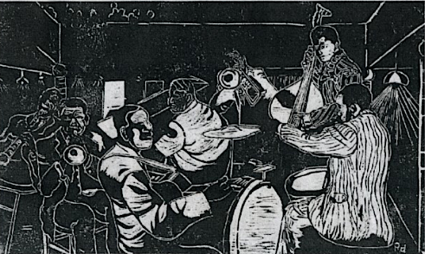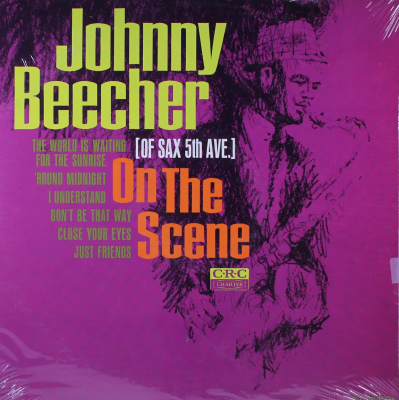.
.
“Take the ‘A’ Train, by Russell duPont

.
.
Treatise on the Moral Imperative of Showing Up for the Gig
……………………….For Bassist and great teacher, Joseph Damrell
Are you jonesing, hands all cold and clammy?
PLAY ON SWEETHEART! It’s just part
of the ambience. I saw Milt Jackson with MJQ
in Madison the first day I ever went to college.
His eyes were a million miles off, but his hands
floated disembodied above the vibraphone. HE
WAS RIGHT THERE but was nowhere near
the building. I was still seventeen but never
the same person after that.
What if you don’t like the leader? No excuse.
Bassist, Charles Mingus punched Jimmy Knepper
right on stage in front of an audience because
he didn’t like what Jimmy was playing. Knepper
played great trombone, including on that night.
Charles was just all the way over on his dark
and crazy side, but I will bet that Jimmy kept
on showing up.
Any exceptions? There was one time, in Chicago,
we were supposed to see Dave Brubeck’s quartet
with Paul Desmond on the alto but he was really
way too sick to make the trip so they brought in
Gerry Mulligan on baritone. MULLIGAN! We
were in the last row of Orchestra Hall and we
thought we were in heaven.
But this, up here, is the boonies, fellow travelers,
what they used to call “the territories”—endless woods
finally giving over to the endless prairie, stretched out
like a drumhead across the middle of America, not LA
and not Manhattan, therefore YOU MUST SHOW UP!
Maybe Miles Davis was the surliest s o b who ever blew
great jazz, but I believe he showed up even if he didn’t
always stay. Lee Morgan, another great addicted trumpet
player, showed up until his also drug afflicted wife shot
him into the afterlife, right there on the bandstand in the
place where he was playing.
A bunch of years ago, this bass player and I once got hired
by a later version of the old Glenn Miller Band for a dance
here, at the Elks Club, because one of their sax players and
the bassist went to Ashland, Kentucky by mistake instead
of this one in Wisconsin. BUT THEY STILL SHOWED UP
or meant to, so we showed up too, and on short notice and
didn’t mind the young dudes in the group treating us like
farm boys because we weren’t New York and not even
Milwaukee.
Therefore, if you are not deceased, you need to find a way to
GET YOUR ASS down to the club, hall, basement, attic or
café and make some music— because art is long, because
there’s no difference between love and love song, because
your friends await you, and because they do not only wish
to drink and pass the time. They need to dance.
.
.
___
.
.

Joel Glickman taught music including jazz history and the jazz band at Northland College, Ashland Wisconsin, from 1974 until retirement in 2017, where he has resumed teaching about jazz again, part time. He has written and published poetry over a wide range of subjects. Primarily a classical clarinetist and folk singer-song writer and banjo player, his jazz and saxophone skills lag behind these. He resides in Ashland with wife Susan and their Bichon, Madeline.
.
.
___
.
.

Russell duPont is an artist and an author whose artwork is included in a number of public and private collections. He has published two novels, King & Train and Waiting for the Turk; two books of poetry; and two non-fiction chapbooks. His essay, “The Corner,” is included in the anthology Streets of Echoes. His work has been published in various newspapers and literary magazines. He was the founder & publisher of the literary magazine,.the albatross.
Visit his website by clicking here
.
.
Listen to the 1972 recording of the Dave Brubeck Trio, with Gerry Mulligan playing “Basin Street Blues,” with Brubeck (piano); Mulligan (baritone saxophone); Jack Six (bass); and Alan Dawson (drums). [Legacy/Columbia]
.
.
___
.
.
Click here for information about how to submit your poetry
Click here to subscribe to the Jerry Jazz Musician quarterly newsletter
Click here to help support the continuing publication of Jerry Jazz Musician (thank you!)
.
.
.
.
































